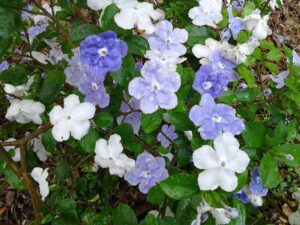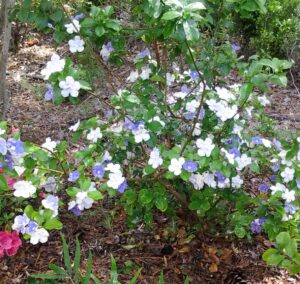S & J Tree Farm and Nursery’s
Yesterday Today and Tomorrow
( Brunfelsia pauciflora ‘Floribunda’ )
Brunfelsia Pauciflora ‘Floribunda’ Origins:
– Native to the Tropical Americas, Brunfelsia pauciflora ‘Floribunda’ is right at home in our Northeast Florida subtropical climate zone. Here in our Jacksonville and St. Augustine area nurseries we grow both the free flowering more compact Brunfelsia Pauciflora and the larger growing Brunfelsia Grandiflora with equal success. They are relatively pest free and bloom reliably in the spring and fall and a few on and off blooms during the summer months may even surprise you!
For me in my home gardens Yesterday Today and Tomorrow shrubs are a personal favorite and rarely pay them any attention and often forget to even fertilize them only to be consistently rewarded with beautiful blooms. For me, this is the perfect plant for the ‘non gardener’ or ‘new gardener’ who wants to look like your a pro!
Yesterday Today and Tomorrow Exposure:
– Brunfelsia pauciflora ‘Floribunda’ shrubs will prefer a full sun or partially shaded location in the Northeast Florida landscape.
– Filtered sun near or under taller shade trees
– Morning sun with afternoon shade
– Morning shade with afternoon sun
Brunfelsia pauciflora ‘Floribunda’ Foliage:
– Medium green colored foliage tends to be a bit deeper green in a more shaded garden area.
– Evergreen foliage
Brunfelsia pauciflora ‘Floribunda’ Soil Preference / Salt
tolerance:
– Yesterday Today and Tomorrow will prefer a well draining soil. Amend the soil when planting into predominately sandy soils.
– Salt tolerance unknown.
Brunfelsia pauciflora ‘Floribunda’ Size Variance and Growth Habits:
– Yesterday today and tomorrow shrubs can grow to be 4-6 ft tall and 4 ft wide if left to grow untrimmed. trimmed these slow growing shrubs can be kept at 2.5-3 ft easily with just annual pruning.
– Slow to moderate grower with a strong upright habit.
 Blooms of the Yesterday Today and Tomorrow flowering shrub:
Blooms of the Yesterday Today and Tomorrow flowering shrub:
-Brunfelsia may be one of the most underused plants available in the North Florida area, their easy care and pest resistance should alone make them a popular choice for our subtropical landscapes. But somehow they
have remained a hard to find and seldom used landscape plant. Some things just make no sense to me, and the lack of Brunfelsias in North Florida landscapes is defiantly mind boggling as a gardener! Depending on
the variety you purchase, Brunfelsias will blooms in the spring, again in the fall and some even bloom during summer.
”Floribunda’ is a prolific bloomer that will cover itself in blooms of white lavender and deep dark purple all at the same time. The heaviest bloom will occur during spring followed by a few blooms sporadically
during the summer and fall months in our Northeast Florida Landscapes.
Water Requirements:
– Brunfelsia need careful attention to watering when first planted as do all flowering plants in our hot climate zone, but will only need weekly irrigating during dry spells once rooted and established into the landscape.
Care of S & J Nursery’s Brunfelsia pauciflora ‘Floribunda’ shrubs for North Florida | Jacksonville | St. Augustine area landscapes:
– Brunfelsia shrubs can be planted in the North Florida | Jacksonville | St.Augustine area at any time during the year. In normal and well draining soils dig the hole as deep as the root ball and two to three times as wide.
Plant the top of the root ball level or slightly higher than the surrounding soils. When planting in poorly drained soils make sure to plant your shrubs a minimum of 3 inches ABOVE the surrounding soil level.
– Water every day during the establishment period. For most 3 gallon size shrubs in the North Florida landscape in average soil, that is neither heavy clay that holds water or really sandy that will take 2-3 weeks of daily
watering to ensure that your newly planted shrub will begin to put out new roots and grow into its new home happily. After the first few weeks begin tapering back your watering to every other day then every third day and so
on until your newly planted items are flourishing without your assistance.
– If planting larger shrubs you may need to extend the initial care a bit longer to protect your investment and get your shrubs off to the best start possible.
– IMPORTANT: If planting shrubs in heavy clay soils that hold allot of water after a rain or irrigating, remember to check the soil for moisture by sticking your fingers into the soil near the root ball of the newly
planted shrub down to 2-3 inches. If it remains wet from the previous watering wait for the top 2-3 inches to dry out before watering again.
– IMPORTANT: When planting shrubs into sandy soils be sure to amend the soil with compost or cow manure etc. Mix the amendment with the native soil that will go back in the hole and place the mixture around the root ball to fill in the sides of the hole. This additional care at planting time will not only give your new shrubs good soil to grow its new roots into but help it hold onto the available water from rain and supplemental irrigation.
– When planting shrubs from containers be sure to loosen the roots as much as possible pulling loose roots away from the root ball before installing your new plants, if the roots are to tight to easily loosen with your hands
use a knife to cut a few slits into the root ball being careful to go all the way from the top to the bottom and making the cut at least an inch deep. This will ensure that your plant will immediately begin to form new roots
into its new surrounding soil.
– Mulch newly planted shrubs as soon as possible after planting.
– Fertilize each spring with a mixture of Milorganite and a slow release poly coated plant food such as Osmocote or Stay Green general purpose plant food, sprinkling the fertilizer around the mulch circle underneath the foliage of the tree
– Prune as needed to shape each spring and or summer.

